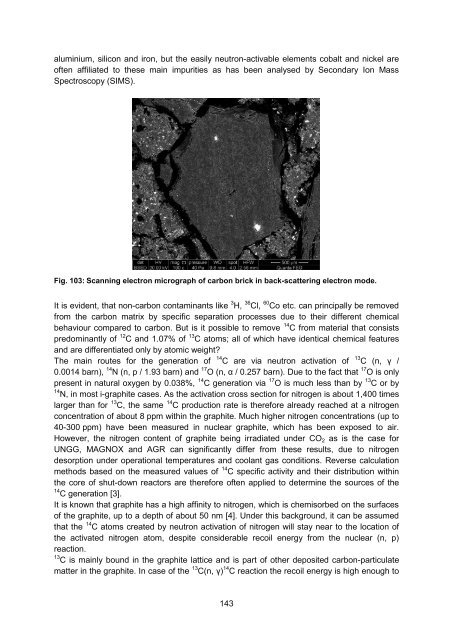Annual Report 2009/2010 - JUWEL - Forschungszentrum Jülich
Annual Report 2009/2010 - JUWEL - Forschungszentrum Jülich
Annual Report 2009/2010 - JUWEL - Forschungszentrum Jülich
Create successful ePaper yourself
Turn your PDF publications into a flip-book with our unique Google optimized e-Paper software.
aluminium, silicon and iron, but the easily neutron-activable elements cobalt and nickel are<br />
often affiliated to these main impurities as has been analysed by Secondary Ion Mass<br />
Spectroscopy (SIMS).<br />
Fig. 103: Scanning electron micrograph of carbon brick in back-scattering electron mode.<br />
It is evident, that non-carbon contaminants like 3 H, 36 Cl, 60 Co etc. can principally be removed<br />
from the carbon matrix by specific separation processes due to their different chemical<br />
behaviour compared to carbon. But is it possible to remove 14 C from material that consists<br />
predominantly of 12 C and 1.07% of 13 C atoms; all of which have identical chemical features<br />
and are differentiated only by atomic weight?<br />
The main routes for the generation of 14 C are via neutron activation of 13 <br />
0.0014 barn), 14 N (n, p / 1.93 barn) and 17 17 O is only<br />
present in natural oxygen by 0.038%, 14 C generation via 17 O is much less than by 13 C or by<br />
14 N, in most i-graphite cases. As the activation cross section for nitrogen is about 1,400 times<br />
larger than for 13 C, the same 14 C production rate is therefore already reached at a nitrogen<br />
concentration of about 8 ppm within the graphite. Much higher nitrogen concentrations (up to<br />
40-300 ppm) have been measured in nuclear graphite, which has been exposed to air.<br />
However, the nitrogen content of graphite being irradiated under CO 2 as is the case for<br />
UNGG, MAGNOX and AGR can significantly differ from these results, due to nitrogen<br />
desorption under operational temperatures and coolant gas conditions. Reverse calculation<br />
methods based on the measured values of 14 C specific activity and their distribution within<br />
the core of shut-down reactors are therefore often applied to determine the sources of the<br />
14 C generation [3].<br />
It is known that graphite has a high affinity to nitrogen, which is chemisorbed on the surfaces<br />
of the graphite, up to a depth of about 50 nm [4]. Under this background, it can be assumed<br />
that the 14 C atoms created by neutron activation of nitrogen will stay near to the location of<br />
the activated nitrogen atom, despite considerable recoil energy from the nuclear (n, p)<br />
reaction.<br />
13 C is mainly bound in the graphite lattice and is part of other deposited carbon-particulate<br />
matter in the graphite. In case of the 13 14 C reaction the recoil energy is high enough to<br />
143
















